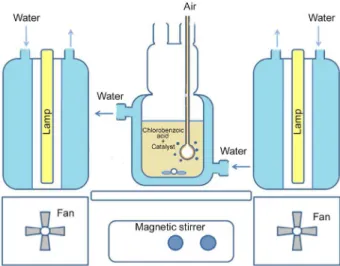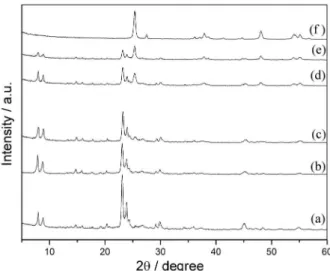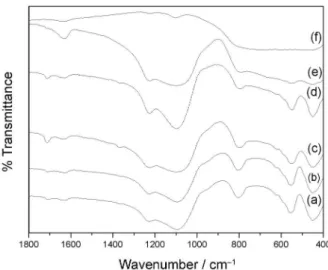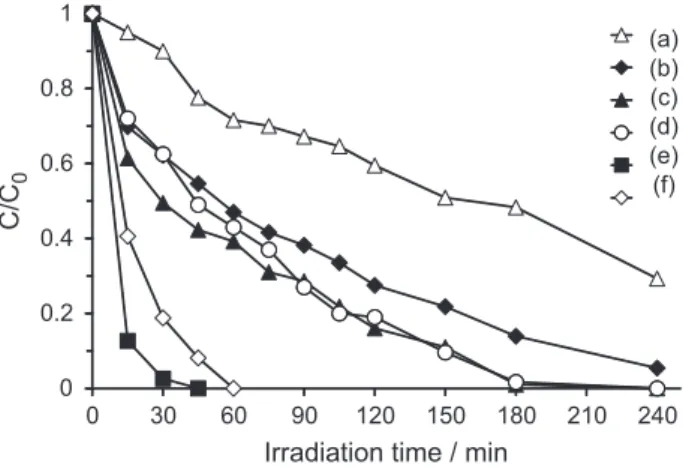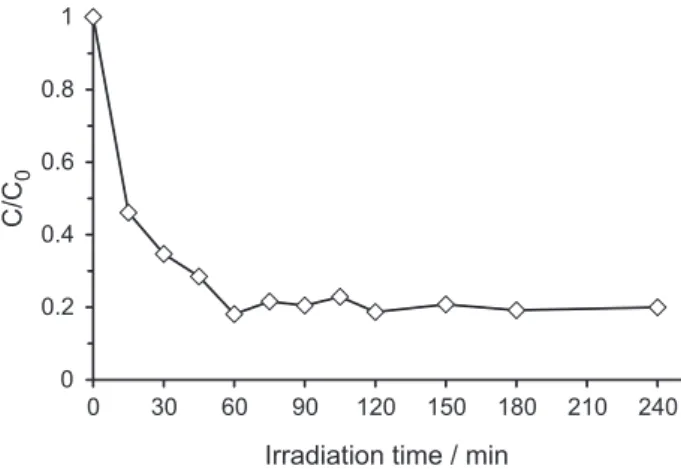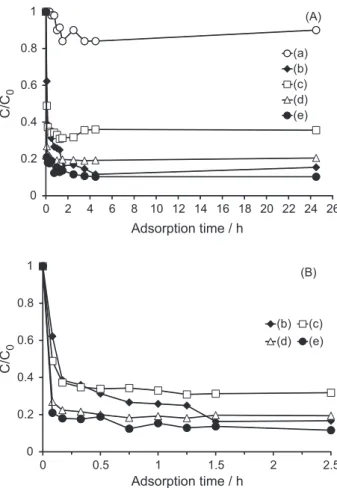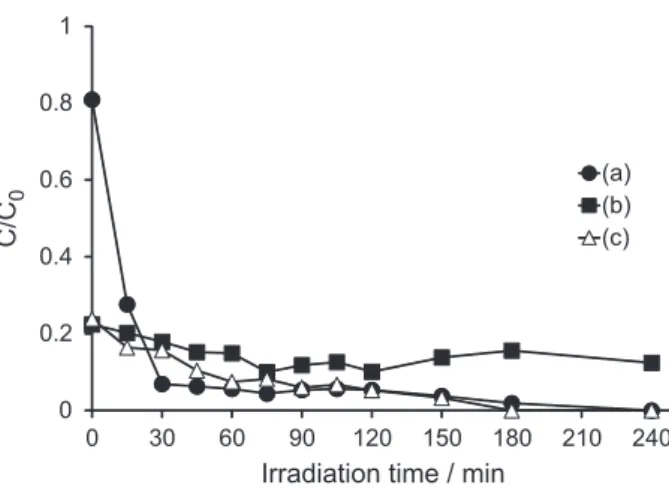Article
Printed in Brazil - ©2015 Sociedade Brasileira de Química0103 - 5053 $6.00+0.00A
*e-mail: lpierella@scdt.frc.utn.edu.ar
TiO
2Supported on HZSM-11 Zeolite as Efficient Catalyst for the Photodegradation
of Chlorobenzoic Acids
Juan P. Montañez,a,b Silvina Gómez,b,c Ana N. Santiagoa,b and Liliana B. Pierella*,b,c
aInstituto de Investigaciones en Físico-Química de Córdoba (INFIQC), Departamento de Química
Orgánica, Facultad de Ciencias Químicas, Universidad Nacional de Córdoba, Córdoba, 5000, Argentina
bConsejo Nacional de Investigaciones Científicas y Técnicas (CONICET), C1033AAJ, Argentina
cCentro de Investigación y Tecnología Química (CITeQ), Facultad Córdoba,
Universidad Tecnológica Nacional, Córdoba, 5000, Argentina
The photocatalytic decomposition of 2-, 3- and 4-chlorobenzoic acids (2CB, 3CB and 4CB, respectively) with TiO2 loaded on HZSM-11 zeolite was investigated. The optimum decomposition rate of 2CB was obtained with TiO2/HZSM-11(30%) (TiO2 30 wt.%) catalyst at a concentration of 1 mg mL-1. 2CB and 3CB decompose at similar rates, but 4CB remains adsorbed on
TiO2/HZSM-11(30%) without further degradation. This absorption is attributed to the relative
positions of Cl and COOH groups on 4CB. However, this compound can be partially degraded and/or removed from aqueous solutions by TiO2/HZSM-11(50%) catalyst or HZSM-11 zeolite. TiO2/HZSM-11(30%) is stable; it retains its photocatalytic properties after nine cycles, can be easily removed and immediately reused. These are important advantages of TiO2/HZSM-11(30%)
over unsupported TiO2, making it a good photocatalyst for the treatment of polluted water. On
the other hand, HZSM-11 could be used to selectively adsorb 4CB, thus becoming an alternative method of environmental remediation.
Keywords: aromatic acids, heterogeneous photocatalysis, supported catalysts, TiO2, zeolite
Introduction
Aromatic acids are used in wood preservatives, paints,
vegetal ibers and leather due to their bactericidal activity.1
They are also used as raw materials for the synthesis
of herbicides, pesticides, pharmaceuticals and dyes.2-4
Furthermore, they are end products of the biodegradation
of aromatic industrial contaminants.2 Chlorobenzoic acids
are environmental pollutants produced mainly by the biodegradation of polychlorinated biphenyls and some
herbicides.5 One of them, 2-chlorobenzoic acid (2CB) is
present in efluents from the pharmaceutical industry, and
as such, it can contaminate natural water courses.6 These
chloroaromatic acids are persistent in the environment, adversely affecting the lora and fauna.
Many different methods have been used to remove these contaminants from wastewater, photodegradation by UV radiation being one of the most effective. Through
this process a large variety of organic products can
be completely mineralized.6 TiO
2 is the most widely
photocatalyst used; however, once the reaction has been completed this compound cannot be easily removed from an aqueous medium as it remains in suspension and expensive special iltration equipment has to be used. An alternative is
the use of TiO2 immobilized on a porous material such as
zeolites; these materials have channels, pores and cavities
which may improve the selectivity of TiO2 and increase
the reactivity of the substrate to be oxidized, leading to
an increase of its photocatalytic activity.7 Zeolites have
proven to be efficient support materials for titania in
the photodegradation of salicylic acid (TiO2/MCM-41),8
an azo-dye (TiO2/β and TiO2/montmorillonite),9 ethinyl
estradiol (TiO2/low-silica X zeolite),10 EDTA (TiO
2/ZSM-5)11
and amoxicillin (TiO2/natural zeolite).12
In particular, ZSM-11 zeolite framework structure is
very similar to that of ZSM-5 zeolite.13 Unlike this zeolite
This property enhances the molecular diffusion, inside the zeolite cavities, by reducing the tortuosity factor. Also, ZSM-11 zeolite does not lose their initial crystalline structure after chemical and thermal treatments, unlike
other zeolites, e.g., Y zeolites.14
In a previous report15 this catalyst has proven to be
effective to degrade dichlorvos, a non-ionizable insecticide, under UV-irradiation. In this study, the photocatalytic
activity of TiO2 supported on HZSM-11 zeolite was
evaluated in 2CB degradation, considering the effects of
catalyst concentration, wt.% of TiO2 loaded on HZSM-11,
and the repeatability of the photocatalytic activity of the catalyst after multiple cycles of reuse. The degradation rate of three ionizable compounds, 2CB and its isomers 3- and 4-chlorobenzoic acids (3CB and 4CB, respectively), were also compared under conditions similar to solar radiation.
The main goal of this research is to expand the number of compounds that can be degraded by this catalyst, because it is highly desirable that a catalyst can degrade different pollutants. This property is very useful to develop an adequate and eficient methodology for efluent and natural watercourses remediation. To our knowledge, studies on the photodegradation of these three isomers (2CB, 3CB
and 4CB) by TiO2 supported on HZSM-11 zeolites have
not yet been reported.
Experimental
Reagents
HZSM-11 zeolite was prepared using the following
reactants: sodium aluminate (NaAlO2, Johnson Matthey
Electronics), tetrabutylammonium hydroxide (TBAOH, Fluka), silicic anhydride (Fluka) and distilled water. Titanium(IV) isopropoxide, 2CB, 3CB and 4CB acids were purchased from Aldrich and used as received. Ethanol
(Cicarelli) was employed. P25, standard TiO2, was kindly
supplied by Degussa.
Preparation of TiO2/HZSM-11-supported catalyst
The parent Na-ZSM-11 zeolite (Si/Al = 17) was
obtained by known hydrothermal crystallization methods.15
The ammonium form of the zeolite (NH4-zeolite) was
prepared by ion exchange from Na-zeolite with 1 mol L-1
ammonium chloride solution at 80 ºC for 40 h. Finally,
NH4-zeolite was dried at 110 ºC, treated in a nitrogen low
at 500 ºC during 8 h and then calcined in air at the same temperature for 10 h, obtaining the HZSM-11 zeolite.
The supported catalysts were prepared by mixing appropriate amounts of titanium(IV) isopropoxide and
zeolite in ethanol. This mixture was mechanically stirred for 4 h at ambient temperature, and then the solvent was removed by evaporation. The mixture was then dried at 110 ºC and calcined in air at 450 °C. The amount of titanium(IV) isopropoxide was changed with the purpose of generating
in situ theoretical TiO2 concentrations of 3, 10, 30 and 50 wt.%
in the inal solid. They were labeled TiO2/HZSM-11(3%),
TiO2/HZSM-11(10%), TiO2/HZSM-11(30%) and
TiO2/HZSM-11(50%), respectively. Commercial TiO2 (P25,
Degussa) was also employed for comparison.
Characterization
The catalysts were previously characterized by X-ray diffraction (XRD), transmittance Fourier transform infrared spectroscopy (FTIR), speciic surface areas by the Brunauer-Emmett-Teller (BET) method, scanning electron microscopy (SEM), inductively coupled plasma optical emission spectroscopy (ICP-OES), and UV-Vis diffuse
relectance spectroscopy (DRS).15
Photocatalytic activity evaluation
All experiments were performed in triplicate in a borosilicate water-jacketed glass reactor, irradiated with two Philips Master HPI-T Plus 400 W lamps water-air cooled (Figure 1), with an emission interval ranging from 350 to 650 nm, according to the manufacturer’s speciications. The emission spectrum of these lamps is very similar to sunlight emission spectrum at sea level.
Photocatalytic activity measurements were conducted on
the catalysts TiO2/HZSM-11(3%), TiO2/HZSM-11(10%),
TiO2/HZSM-11(30%), and TiO2/HZSM-11(50%) in
different concentrations: 0.25, 0.5, 1 and 2 mg mL-1. For
this purpose, a 10-4 mol L-1 aqueous solution of 2CB, 3CB or
4CB containing the photocatalyst in suspension was allowed to equilibrate in the dark for 30 min with mechanical stirring and without air bubbling. Subsequently, this mixture was irradiated for 4 h and atmospheric air bubbling. Aliquots were withdrawn at speciic time intervals and analyzed after iltration with 0.45 µm Millipore membrane to remove catalyst particles. The starting aliquot corresponds to the time at which the lamps were turned on.
The aliquots were then analyzed on a Waters 1525 high-performance liquid chromatography (HPLC) equipment with an Agilent Zorbax Eclipse XDB-C18 5 µm column and a UV-Vis photodiode array detector operating between
190-370 nm.1 A mixture of methyl alcohol (40% v/v) and
acetic acid/sodium acetate buffer (pH 4, 60% v/v) was used
as mobile phase at a low rate of 0.3 mL min-1. Twenty-ive
milliliters of each aliquot were injected and analyzed at a
wavelength of 236 nm.6 Direct photolysis of 2CB was also
studied irradiating a 2CB solution for 4 h in the absence of the photocatalyst.
Photodegradation reactions with catalysts TiO2/
HZSM-11(3%), TiO2/HZSM-11(10%), TiO2
/HZSM-11(30%) and TiO2/HZSM-11(50%) were compared with
the uncharged matrix (HZSM-11) and unsupported TiO2.
In addition, adsorption studies of 2CB or 4CB were carried out at room temperature (25 ºC). For this purpose,
a 10-4 mol L-1 aqueous solution of 2CB or 4CB containing
the photocatalyst in suspension was keep in the dark for 24 h with mechanical stirring and air bubbling. Aliquots were withdrawn at speciic time intervals and analyzed as described above.
The conservation of the photocatalyst activity was determined by the percentage of degradation of 2CB after irradiation, and was calculated as follows for every cycle:
Degradation percentage = (1 – C / C0) × 100 (1)
where C is the 2CB concentration in the solution after 2 h of
irradiation, and C0 is the initial concentration (10-4 mol L-1).
Results and Discussion
Characterization of TiO2/H-zeolite catalysts
XRD analysis
In order to conirm the structure and crystallinity of
TiO2/zeolite catalysts, an XRD study was carried out. Figure
2 shows the XRD patterns of HZSM-11 (a) and different titania-supported catalysts (b-e). For comparative purposes, the diffraction pattern of commercial P25 titania (f)
is also included. Figure 2 shows the characteristic
signal of the parent HZSM-11 catalyst at 2θ angles of
23-24º and 7-9º, which were assigned to (332), (303) and
(101), (200) planes, respectively.16 The XRD pattern of
TiO2/H-ZSM-11(3%) catalyst (Figure 2b) was essentially
the same as that of the original HZSM-11 (Figure 2a).
TiO2/HZSM-11 prepared in this study showed diffraction
peaks at 25.4, 48.2, 54.9 and 55.4°, which were assigned to the characteristic relections from (101), (200), (211) and
(106) planes of anatase, respectively.17 In the diffraction
pattern of TiO2/HZSM-11(10%), the peak at (101) is barely
observed, but the other three peaks are not clearly observed
since the amount of TiO2 would not be enough to give clear
diffraction peaks.
The peak intensity at 2θ = 25.4° increased with an
increasing amount of TiO2 loaded on HZSM-11. A similar
XRD pattern was obtained for TiO2/zeolites (Y, A and
BEA), as reported previously.18,19 Simultaneously with the
increase in the TiO2 load, a small decrease in the intensity
of HZSM-11 diffraction peaks was observed. However, this decrease can be attributed to a dilution effect of the zeolite matrix in the catalyst.
On the other hand, no peak assigned to rutile phase
(2θ = 27.4º) was observed in the XRD patterns of all
TiO2/HZSM-11 catalysts used in the present study.
FTIR spectra
Figure 3 shows the FTIR spectra of bulk TiO2,
bulk zeolite and TiO2/HZSM-11(wt.%) in the range of
1800-400 cm-1. All the zeolitic materials present vibrations
assigned to the internal bonds of a TO4 tetrahedral structure
(T = Si or Al) that are insensitive to changes in the zeolite
Figure 2. XRD pattern of (a) zeolite HZSM-11, (b) TiO2/HZSM-11(3%),
structure, 1250-950, 850-700 cm-1 and the signals at 500
to 420 cm-1 being attributed to asymmetrical stretching, to
the symmetrical stretching and to (O–T–O) deformation, respectively. Furthermore, vibrations assigned to the
external bonds of the TO4 tetrahedral structure, which are
sensitive to changes in the structure, can also be observed.
These vibrations, in the region between 650 and 500 cm-1,
are attributed to those of double rings consisting of ive
atoms. A shoulder between 1050 and 950 cm-1 is assigned
to the asymmetrical stretching of T–O–T bonds.20
No band in the region near 960 cm-1 was detected, which
could be assigned to the antisymmetric stretching vibration
of the Ti–O–Si bonds.19-21 Therefore, the replacement of the
tetrahedral Si sites with Ti during preparation did not take
place. So, we can conclude that TiO2 was deposited on the
surface of the zeolites.
TiO2 crystallite size values, surface area (SBET) and Ti, Si
and Al content of the supported catalysts
The estimated TiO2 crystallite size values (d), the
surface area (SBET) of the supported catalysts and Ti, Si and
Al content (wt.%) are shown in Table 1.
The average crystallite size of TiO2 on the zeolite matrix
was estimated using XRD data and the Scherrer equation. The crystal size varies from 12 to 23 nm, rising with the
increasing load of TiO2, probably due to the aggregation of
the TiO2 particles on the surface of the zeolite.
The surface area (SBET) of the synthesized materials
was determined from the N2 adsorption-desorption
isotherms using the Brunauer-Emmett-Teller method.
The adsorption-desorption isotherms of TiO2
/HZSM-11 samples exhibit characteristics similar to those of
HZSM-11. According to IUPAC classiication, they are type I isotherms, characteristic of microporous solids
having relatively small external surfaces.22 Also, the surface
area of TiO2/HZSM-11(3%) has similar characteristics to
TiO2/HZSM-11(10%). With an increase in TiO2 loading,
a linear decrease in the surface area of the samples can be
observed. It could be possibly due to the deposit of TiO2
particles on the HZSM-11 surface, thus, blocking the pores.
Ti, Si and Al content of TiO2/HZSM-11 catalysts were
determined by ICP-OES. The Ti wt.% increased when
TiO2 loading increased, which is in good agreement with
theoretical values.
UV-Vis DRS
The UV-Vis diffused relectance spectra of zeolite
matrix and TiO2/HZSM-11 samples are shown in Figure 4.
The diffuse relectance spectrum of HZSM-11 (Figure 4a) consists of a single band at 210 nm arising from the Al–O charge-transfer transition of four-coordinated framework
aluminum, characteristic of as-synthesized zeolites.23 In
the supported catalyst (Figures 4b-d), the absorption band at 200-250 nm is due to electron transfer from the
ligand-Figure 3. FTIR of (a) zeolite HZSM-11, (b) TiO2/HZSM-11(3%),
(c) TiO2/HZSM-11(10%), (d) TiO2/HZSM-11(30%), (e) TiO2 /HZSM-11(50%) and (f) P25 Degussa.
Table 1. Crystallite size of TiO2, surface area, Ti, Si and Al content (wt.%)
of TiO2/HZSM-11 catalysts
Samplea d / nm S
BET / (m2 g-1) Ti Si Al
1 – 382 – 28.934 1.700
2 – 370 1.243 27.560 1.650
3 12.04 365 4.846 25.609 1.502
4 18.86 309 16.756 22.812 1.342
5 22.98 255 27.200 21.450 1.245
a1: HZSM-11, 2: TiO
2/HZSM-11(3%), 3: TiO2/HZSM-11(10%),
4: TiO2/HZSM-11(30%) and 5: TiO2/HZSM-11(50%).
Figure 4. DRS of (a) zeolite HZSM-11, (b) TiO2/HZSM-11(10%),
oxygen to an unoccupied orbital of the Ti4+ framework.24
The spectra are also characterized by an intense band centered at 320 nm, corresponding to charge transfer from
the valence band (O 2p) to the conduction band (Ti 3d).25
The determination of the band gap (Eg) from the UV-Vis spectra is an alternative method to study the modiication
of the electronic properties of the TiO2 species.26 The band
gap of TiO2 can be affected by the particle size (quantum
size effects) and the particle size could be affected by
the thermal treatment temperature and of TiO2 contents
among others for TiO2 hybrid systems.27-29 The band gap
energies were estimated from UV-Vis DRS spectra using
the Kubelka-Munk remission function,30 and the values
(in eV) obtained were 3.25 (TiO2/HZSM-11(10%)), 3.15
(TiO2/HZSM-11(30%)) and 3.12 (TiO2/HZSM-11(50%)).
The UV-Vis DRS spectra of the TiO2/HZSM-11 samples
showed the absorption threshold onset was scarcely shifted
to the visible region when the TiO2 concentration increased.
As result, the Eg values present a small variation when
varying TiO2 content in the samples.
Effect of wt.% of TiO2 loaded on HZSM-11
Figure 5 shows the photocatalytic decomposition of
2CB on TiO2/HZSM-11(3%), TiO2/HZSM-11(10%),
TiO2/HZSM-11(30%), and TiO2/HZSM-11(50%) catalysts
(1 mg mL-1 in all reactions). It also shows that 2CB does not
photolyse and does not decompose with HZSM-11 zeolite.
The degradation rate of 2CB increases with TiO2
loading, except for the TiO2/HZSM-11(50%) catalyst.
In this case, its lower photocatalytic activity may be
due to the agglomeration of TiO2 particles, as observed
by Ding et al.31 on the degradation of phenol with
TiO2/silica gel catalysts.
TiO2/HZSM-11(30%) was the most eficient catalyst,
since 2CB was completely degraded after 3 h irradiation; it was, therefore, chosen for the following experiments.
2-Chlorophenol (2CP) is the major metabolite in the
photodegradation of 2CB.6,32 However, it was not observed
in the reactions described in this work, although we tried to ind this product using an aqueous solution of pure 2CP as standard. Probably 2CP forms slowly and it is immediately degraded by the photocatalyst in the reaction media.
Effect of catalyst concentration
A series of experiments was carried out to ind the
optimum amount of catalyst by varying TiO2/HZSM-11(30%)
concentration from 0.25 to 2 mg mL-1 (Figure 6).
The decomposition rate increases with the amount of
TiO2/HZSM-11(30%) up to 1 mg mL-1, but above this
concentration the decomposition rate is not further increased.
The concentration of the photocatalyst increases the amount of active sites as well, resulting in an improvement
of the photocatalysis rate. However, when 2 mg mL-1 was
added this rate was kept unchanged, probably due to the scattering of a fraction of incident radiation by the higher amount of particles present in the 2CB solution. This effect
was previously observed by other authors.7,33 Starting
from a certain concentration of TiO2/HZSM-11(30%) the
2CB solution becomes opaque due to suspended particles,
preventing irradiation of active sites.34
The optimum amount of TiO2 catalyst can reach values
from 0.07 to 12 g L-1 depending on light intensity, wavelength,
oxidizing agents, kind of contaminant, and so on.33 In our
work, the optimum amount of TiO2/HZSM-11(30%) catalyst
is 1 mg mL-1, which corresponds to 0.3 g L-1 of TiO
2.
0 0.2 0.4 0.6 0.8 1
0 30 60 90 120 150 180 210 240
C/C
0
Irradiation time / min
(a) (b) (c) (d) (e) (f)
Figure 5. Photolysis (a) and photocatalytic decomposition of 2CB over
(b) HZSM-11, (c) TiO2/HZSM-11(3%), (d) TiO2/HZSM-11(10%), (e) TiO2/HZSM-11(30%) and (f) TiO2/HZSM-11(50%) catalysts.
C/C
0
0 0.2 0.4 0.6 0.8 1
0 30 60 90 120 150 180 210 240
Irradiation time / min
(a) (b) (c) (d) (e) (f)
Figure 6. Effect of the amount of TiO2/HZSM-11(30%) catalyst on the
photocatalytic decomposition of 2CB: (a) 0.25 mg mL-1, (b) 0.5 mg mL-1,
(c) 1 mg mL-1 and (d) 2 mg mL-1. Unsupported TiO
2 (from Degussa) is
As seen in Figure 6, photocatalysis was faster when
unsupported TiO2 was used at a concentration of 1 or
0.3 mg mL-1. The latter is equivalent to the TiO
2 load present
in TiO2/HZSM-11(30%), a concentration of 1 mg mL-1. This
may also be due to the total amount of particles present in the solution. Zeolite HZSM-11 allows the passage of radiation but it possibly scatters a fraction of the incident radiation, an effect that does not occur in solutions with
unsupported TiO2. However, although unsupported TiO2
is a better photocatalyst in these reactions, it cannot be
recovered easily35 requiring expensive and laborious
methods of separation of treated solutions. By contrast, the
TiO2/HZSM-11(30%) catalyst can be easily recovered from
the reaction medium by iltration. Also, the spontaneous
agglomeration of unsupported TiO2 particles, when
dispersed in aqueous media, may cause a rapid decrease in speciic surface area, thereby photocatalytic activity
decays.36
Considering that the solution of 2CB (pKa 2.92) has a pH of 4.1, the carboxylate anion:protonated acid ratio is
17:1. Since the point of zero charge of TiO2 is ca. 6.25,7 this
catalyst surface is positively charged at this pH, and thus photocatalysis of this organic pollutant is promoted by the
electrostatic attraction between TiO2 and the anion of 2CB.
Leaching study of the catalyst
A rigorous proof of heterogeneity can be obtained only by iltering the catalyst at the reaction temperature before completion of the reaction and then testing the iltrate for
catalytic activity.37 In order to check the stability of the
TiO2/HZSM-11(30%) catalyst, a 10-4 mol L-1 solution
of 2CB containing 1 mg mL-1 of the photocatalyst was
irradiated for 1 h. After that time TiO2/HZSM-11(30%) was
removed from the solution by iltration, and the remaining solution was irradiated for 3 more hours. The results obtained can be seen in Figure 7.
After the irst hour, 2CB concentration decreased to 18% of its original value, keeping constant for 3 h thereafter. These
results would indicate that TiO2 does not become detached
from the zeolite matrix, but remains attached throughout the reaction. In other words, there is then no detectable
leaching of the catalyst in the reaction media.Consequently,
TiO2/HZSM-11(30%) catalyst is a very stable structure,
which remains unchanged during whole reaction time.
Effect of H2O2 on the photocatalytic process
To investigate the effect of adding H2O2 on the
photocatalysis of 2CB, experiments with four different
amounts of H2O2 were carried out.
The most important effect of adding H2O2 is the
photogeneration of OH• radicals with UV light up to
350 nm,38 as can be seen in equation 2. This should increase
the reaction rate.
H2O2 hυ 2OH (2)
However, other researchers39 indicate that H
2O2 can
trap photo-induced electrons, and may partially contribute to the photodegradation rate with another mechanism (equation 3). This mechanism reduces the possibility of electron-holes recombination:
H2O2 OH–+OH
e–
(3)
In our research, OH• radicals cannot be generated as shown in equation 2 due to the wavelength range used
(greater than 350 nm, see Experimental), but H2O2 could be
reduced as seen in equation 3. For these reasons, the effect
of H2O2 as electron acceptor was investigated (Figure 8).
0 0.2 0.4 0.6 0.8 1
0 30 60 90 120 150 180 210 240
Irradiation time / min
C/C
0
Figure 7. Leaching study: photocatalytic decomposition of 2CB over
TiO2/HZSM-11(30%).
0 0.2 0.4 0.6 0.8 1
0 30 60 90 120 150 180 210 240
Irradiation time / min
(a) (b) (c) (d) (e)
C/C
0
Figure 8. Photocatalytic decomposition of 2CB over TiO2/HZSM-11(30%)
with four different amounts of H2O2: (a) 2 × 10-3 mol L-1, (b) 1 × 10-3 mol L-1,
The experimental results show that none of the used
amounts of H2O2 was effective to degrade 2CB in less than
3 h, as observed without the addition of H2O2. This result can
be explained considering that the excess of H2O2 molecules
can scavenge OH• radicals40 generated either on the TiO
2
surface or by H2O2 as electron acceptor (equation 3).
At very low concentration (less than 2.5 × 10-4 mol L-1),
H2O2 should reach the TiO2 surface before O2 (concentration
at saturation level: 2.6 × 10-4 mol L-1 at 25 ºC) without
previous decomposition in H2O and O2, to compete with
O2 as electron acceptor. For this reason, H2O2 concentration
less than 2.5 × 10-4 mol L-1 was not employed. With TiO
2,
addition of H2O2 is valuable only if it can be used to
generate OH• radicals with UV light, as can be seen in equation 2.
Influence of the relative position of Cl and COOH groups on an aromatic ring
Comparative photocatalytic degradation of 2CB, 3CB and 4CB
To assess the possible effect of the relative position of Cl and COOH on an aromatic ring, the photodegradation of 3CB and 4CB acids were carried out in the best conditions
found for the photocatalysis of 2CB with TiO2
/HZSM-11(30%). The results obtained with 2CB, 3CB and 4CB compounds are shown in Figure 9.
The degradation of 2CB and 3CB are similar, indicating
that when Cl is in ortho or meta position with respect to
the COOH group, the reactivity is comparable. It is also easy to see (Figure 9) that these compounds do not show signiicant adsorption on the zeolitic matrix during the equilibration time prior to irradiation.
However, 4CB shows a completely different behavior (Figure 9). During the equilibration time it is signiicantly adsorbed in the zeolitic matrix without further
decomposition. The molecular diameter of 4CB may be
similar to that of benzene (4.2 Å),41 since both substituents
are located on opposite ends of the molecule. If we consider that the pore size of zeolite is less than 5 or 6 Å by the partial
obstruction with TiO2 particles, 4CB could enter the interior
of the zeolitic matrix, while 2CB and 3CB have a higher molecular diameter (6-7 Å), which does not facilitate their entry into the zeolitic matrix.
Adsorption of 2CB and adsorption and photocatalytic degradation of 4CB
Adsorption studies of 2CB and 4CB were carried out
over HZSM-11 zeolite and TiO2/HZSM-11(30%) catalyst
at different concentration, as can be seen on Figure 10. 2CB
is adsorbed in low proportion by TiO2/HZSM-11(30%)
catalyst and can be degraded under irradiation within 3 h, as can be seen on Figure 9.
Adsorption of 4CB depends on catalyst concentration
and is initially promoted by supported TiO2. When the
concentration of the photocatalyst increases the amount of adsorption sites increases as well, resulting in an 0
0.2 0.4 0.6 0.8 1
0 30 60 90 120 150 180 210 240
Irradiation time / min
2CB 3CB 4CB
C/C
0
Figure 9. Photocatalysis of 2CB, 3CB and 4CB over TiO2/HZSM-11(30%). 0
0.2 0.4 0.6 0.8 1
0 0.5 1 1.5 2 2.5
(b) (c)
(d) (e)
(B) 0
0.2 0.4 0.6 0.8 1
0 2 4 6 8 10 12 14 16 18 20 22 24 26
Adsorption time / h
Adsorption time / h
(a) (b) (c) (d) (e)
(A)
C/C
0
C/C
0
Figure 10. (A) Adsorption of 2CB over TiO2/HZSM-11(30%) at (a)
1 mg mL-1. Adsorption of 4CB over HZSM-11 (1 mg mL-1, b) and
TiO2/HZSM-11(30%) at (c) 0.5 mg mL-1, (d) 1 mg mL-1 and (e) 2 mg mL-1.
improvement of the adsorption rate. On the other hand,
at pH value of 4CB solution (4.58) the TiO2 surface is
positively charged and a strong coulombic attraction between 4CB (pKa equal to 3.98) and the supported catalyst takes place. This fact would explain the different rates of adsorption of 4CB on the supported catalyst with respect to that observed for zeolite HZSM-11, within the irst ninety minutes. 80 and 90% of initial 4CB concentration
are retained by TiO2/HZSM-11(30%) catalyst at 1 and
2 mg mL-1, respectively, and 85% of this compound is
strongly adsorbed by HZSM-11 zeolite after 24 h.
4CB is strongly adsorbed over TiO2/HZSM-11(50%)
catalyst (as noted above with TiO2/HZSM-11(30%)
catalyst) at the beginning of the photocatalysis process (Figure 11). This negatively-charged compound partially
neutralizes the positively-charged TiO2 surface. This fact
weakens the driving force of the photocatalytic process, that is, the coulombic attraction between an ionizable compound
and TiO2 catalyst. Therefore, the amount of 4CB on
solution decays slowly until the end of the irradiation time. However, a signiicant amount of 4CB remains strongly adsorbed on zeolitic matrix, ca. 80% of its original value (Figure 11). Sixty-two percent of the adsorbed compound
may be released when the TiO2/HZSM-11(50%) catalyst
is suspended for 48 h in distilled water at pH 9. At this
pH value, 4CB and TiO2 are negatively charged; therefore
this compound may be partially desorbed from the zeolite matrix by electrostatic repulsion.
Initially, unsupported TiO2 was the most efficient
catalyst to degrade 4CB. Nevertheless, after 45 min of irradiation there were no signiicant differences with respect
to TiO2/HZSM-11(50%) catalyst.
It is well known that the adsorption of many organic pollutants on different materials (e.g., activated carbon),
on which TiO2 is supported, signiicantly enhances their
degradation, since it concentrates the substrate around the photocatalyst. However, if the substrate is strongly
adsorbed, it cannot react with TiO2 which precludes the
decomposition.42 This fact would explain the differences
observed in the degradation of 2CB and 3CB with respect to 4CB. In other systems, the lack of adsorption of 4CB on the supporting material signiicantly inluences its rate of
decomposition. When TiO2 is supported on glass iber, 4CB
adsorption on this material is null, and photodegradation
occurs at a constant low rate.43 However, TiO
2 immobilized
on a ceramic surface is more eficient, degrading 64%
of 4CB after 3 h of irradiation.44 Moreover, HZSM-11
zeolite could be used to selectively adsorb the 4CB from polluted waterways, thus becoming an alternative method of environmental remediation.
Repeatability of the photocatalyst activity
The conservation of the catalytic activity of a photocatalyst is a very important factor, as it saves costs and materials, and simpliies removal and reuse.
Photodegradation of 2CB with TiO2/HZSM-11(30%)
catalyst was carried out in several cycles in order to evaluate this property. Thus, a solution of 2CB with
TiO2/HZSM-11(30%) was irradiated for 3 h; then the
catalyst was recovered by iltration and reused immediately, without any treatment, using a new solution of 2CB. Results obtained are shown in Figure 12.
As seen in Figure 12, the photocatalytic activity of TiO2/
HZSM-11(30%) is maintained above 80% degradation in all cases, with 88% average activity. This property of
supported TiO2 had already been proved successful on
photodegradation of dyes,7,45 toluene46 and a β-cyclodextrin.47
Our results show that the TiO2/HZSM-11(30%) catalyst can
0 0.2 0.4 0.6 0.8 1
0 30 60 90 120 150 180 210 240
Irradiation time / min
(a) (b) (c)
C/C
0
Figure 11. Photocatalysis of 4CB over (a) TiO2 and (c) TiO2/HZSM-11(50%)
catalysts. For comparative purposes, photocatalysis of 4CB over (b) TiO2/HZSM-11(30%) has been added to the igure.
0 10 20 30 40 50 60 70 80 90 100
1 2 3 4 5 6 7 8 9
Degradation percentage
Cycles
Figure 12. Activity study: photocatalysis of 2CB at different cycles.
[2CB] = 10-4 mol L-1; TiO
be reused immediately without previous reconditioning (e.g., catalyst drying), maintaining excellent photocatalytic activity for at least nine cycles.
Conclusions
We reported that TiO2/HZSM-11(30%) catalyst, at a
concentration of 1 mg mL-1, was the most effective for
completely degrading 2CB and 3CB after irradiation for 3 h. 4CB photodegradation was less effective with this catalyst. However, this compound can be partially degraded and/or
removed from aqueous solutions by TiO2/HZSM-11(50%)
catalyst or HZSM-11 zeolite. Thus, the relative position of the substituents in the molecule is an important factor that inluences the photodegradation rate of organic compounds with supported catalysts. Based on this, HZSM-11 zeolite could be used to selectively adsorb 4CB from polluted waterways, and therefore becomes an alternative method of environmental remediation.
According to our experiments, the TiO2/HZSM-11(30%)
catalyst is stable in solution, it retains its photocatalytic properties on 2CB after nine cycles, it can be easily removed from the treated solution and immediately reused. These
are very important advantages of TiO2/HZSM-11(30%)
over unsupported TiO2, making it a good photocatalyst
for treatment of polluted waterways. Furthermore, this catalyst could be effective under solar irradiation, saving electrical energy.
Acknowledgements
This work was supported in part by MINCYT-Córdoba, UTN, CONICET, SECYT and ANPCyT. S. G. and J. P. M. gratefully acknowledge receipt of fellowships from CONICET. We wish to thank L. R. Pizzio for his cooperation.
References
1. He, Y.; Grieser, F.; Ashokkumar, M.; J. Phys. Chem. A2011,
115, 6582.
2. Deavers, K.; Macek, T.; Karlson, U.; Trapp, S.; Environ. Sci. Pollut. Res.2010,17, 1355.
3. Li, X.; Zhang, Q.; Tang, L.; Lu, P.; Sun, F.; Li, L.; J. Hazard. Mater.2009, 163, 115.
4. Zona, R.; Solar, S.; Getoff, N.; Sehested, K.; Holcman, J.;
Radiat. Phys. Chem.2010,79, 626.
5. Muzikár, M.; Kresinová, Z.; Svobodová, K.; Filipová, A.; Cvancarová, M.; Cajthamlová, K.; Cajthaml, T.; J. Hazard. Mater.2011, 196, 386.
6. Gandhi, V.; Mishra, M.; Rao, M.; Kumar, A.; Joshi, P.; Shah, D.;
J. Ind. Eng. Chem.2011,17, 331.
7. Huang, M.; Xu, C.; Wu, Z.; Huang, Y.; Lin, J.; Wu, J.; Dyes Pigm.2008,77, 327.
8. Reddy, E.; Davydov, L.; Smirniotis, P.; Appl. Catal., B2003,
42, 1.
9. Bhattacharyya, A.; Kawi, S.; Ray, M.; Catal. Today2004,98, 431.
10. Pan, Z.; Stemmler, E.; Cho, H.; Fan, W.; LeBlanc, L.; Patterson, H.; Amirbahman, A.; J. Hazard. Mater. 2014, 279,
17.
11. Mohamed, R.; Ismail, A.; Othman, I.; Ibrahim, I.; J. Mol. Catal. A: Chem. 2005,238, 151.
12. Kanakaraju, D.; Kockler, J.; Motti, C.; Glass, B.; Oelgemöller, M.; Appl. Catal., B 2015,166-167, 45.
13. Azzolina Jury, F.; Polaert, I.; Estel, L.; Pierella, L. B.;
Microporous Mesoporous Mater.2012, 147, 117.
14. Azzolina Jury, F.; Polaert, I.; Estel, L.; Pierella, L. B.; Appl. Catal., A2013, 453, 92.
15. Gómez, S.; Leal Marchena, C.; Pizzio, L.; Pierella, L.;
J. Hazard. Mater.2013,258-259, 19.
16. Renzini, M.; Sedrán, U.; Pierella, L. B.; J. Anal. Appl. Pyrolysis
2009,86, 215.
17. Porkodi, K.; Arokiamary, S. D.; Mater. Charact.2007,58, 495.
18. Yamaguchi, S.; Fukura, T.; Imai, Y.; Yamaura, H.; Yahiro, H.;
Electrochim. Acta2009, 55, 7745.
19. Petkowicz, D.; Brambilla, R.; Radtke, C.; Silva da Silva, C.; da Rocha, Z. N.; Pergher, S. B.; dos Santos, J. H.; Appl. Catal., A
2009, 357, 125.
20. Anunziata, O. A.; Beltramone, A. R.; Juric, Z.; Pierella, L. B.; Requejo, F. G.; Appl. Catal., A2004,264, 93.
21. Kim, Y.; Yoon, M.; J. Mol. Catal. A: Chem. 2001, 168, 257.
22. Sing, K. S.; Everett, D. H.; Haul, R. A.; Moscou, L.; Pierotti, R. A.; Rouquerol, J.; Siemieniewska, T.; Pure Appl. Chem.
1985, 57, 603.
23. Zanjanchi, M. A.; Razavi, A.; Spectrochim. Acta, Part A2001,
57, 119.
24. Petkowicz, D.; Pergher, S.; Silva da Silva, C.; da Rocha, Z.; dos Santos, J.; Chem. Eng. J. 2010, 158, 505.
25. Liqiang, J.; Xiaojun, S.; Weimin, C.; Zili, X.; Yaoguo, D.; Honggang, F.; J. Phys. Chem. Solids2003,64, 615.
26. Takeda, N.; Ohtani, M.; Torimoto, T.; Kuwabata, S.; Yoneyama, H.; J. Phys. Chem. 1997,101,2644.
27. Kavan, L.; Stoto, T.; Gratzel, M.; Fitzmaurice, D.; Shklover, V.;
J. Phys. Chem.1993,97, 9493.
28. Li, Y.; White, T. J.; Lim, S. H.; J. Solid State Chem.2004,177,
1372.
29. Ohno, T.; Tagawa, S.; Itoh, H.; Suzuki, H.; Matsuda, T.; Mater. Chem. Phys.2009,113, 119.
30. Luís, A. M.; Neves, M. C.; Mendonça, M. H.; Monteiro, O. C.;
Mater. Chem. Phys.2011,125, 20.
31. Ding, Z.; Hu, X.; Lu, G.; Yue, P.; Greenield, P.; Langmuir2000,
32. Herrmann, J.; Guillard, C.; Disdier, J.; Lehaut, C.; Malato, S.; Blanco, J.; Appl. Catal., B2002, 35, 281.
33. Ahmed, S.; Rasul, M.; Brown, R.; Hashib, M.; J. Environ. Manage.2011,92, 311.
34. Xiao, Q.; Zhang, J.; Xiao, C.; Si, Z.; Tan, X.; Sol. Energy2008,
82, 706.
35. Colmenares, J. C.; Magdziarz, A.; J. Mol. Catal. A: Chem.2013,
366, 156.
36. Li, G.; Lv, L.; Fan, H.; Ma, J.; Li, Y.; Wan, Y.; Zhao, X.;
J. Colloid Interface Sci.2010,348, 342.
37. Pirkanniemi, K.; Sillanpaa, M.; Chemosphere2002,48, 1047. 38. Gupta, V.; Jain, R.; Agarwal, S.; Shrivastava, M.; Colloids
Surf., A2011,378, 22.
39. Tseng, D.; Juang, L.; Huang, H.; Int. J. Photoenergy2012,
DOI: 10.1155/2012/328526.
40. Castillo, N.; Ding, L.; Heel, A.; Graule, T.; Pulgarin, C.;
J. Photochem. Photobiol., A2010,216, 221.
41. Krachenbuehl, F.; Stoeckli, F.; Addour, A.; Ehrburger, P.; Donnet, J.; Carbon1986,24, 483.
42. Shankar, M.; Cheralathan, K.; Arabindoo, B.; Palanichamy, M.; Murugesan, V.; J. Mol. Catal. A: Chem.2004,223, 195.
43. Enríquez, R.; Agrios, A.; Pichat, P.; Catal. Today2007,120, 196.
44. Dionysiou, D.; Suidan, M.; Baudin, I.; Laîné, J.; Appl. Catal., B
2004,50, 259.
45. Yuan, R.; Zheng, J.; Guan, R.; Zhao, Y.; Colloids Surf., A2005,
254, 131.
46. Lu, X.; Jiang, J.; Sun, K.; Cui, D.; Appl. Surf. Sci.2011,258, 1656.
47. Yuan, R.; Guan, R.; Zheng, J.; Scr. Mater.2005,52, 1329.
Submitted: October 21, 2014
